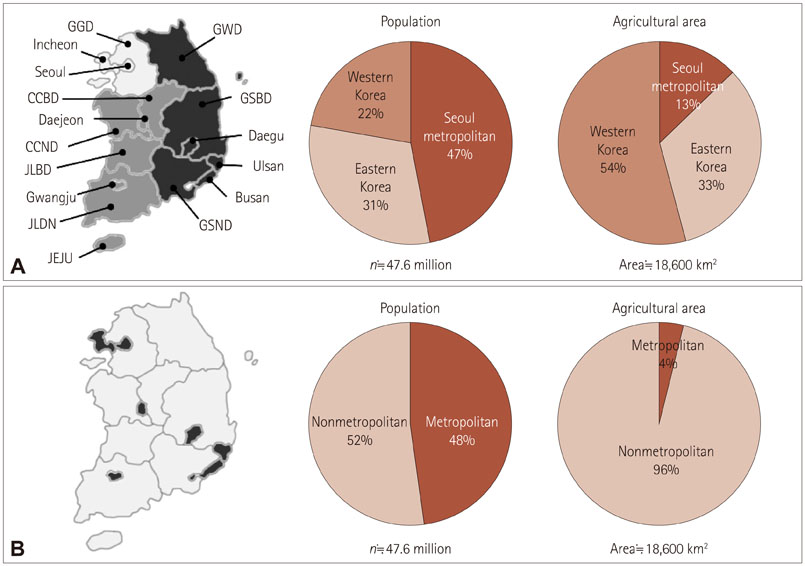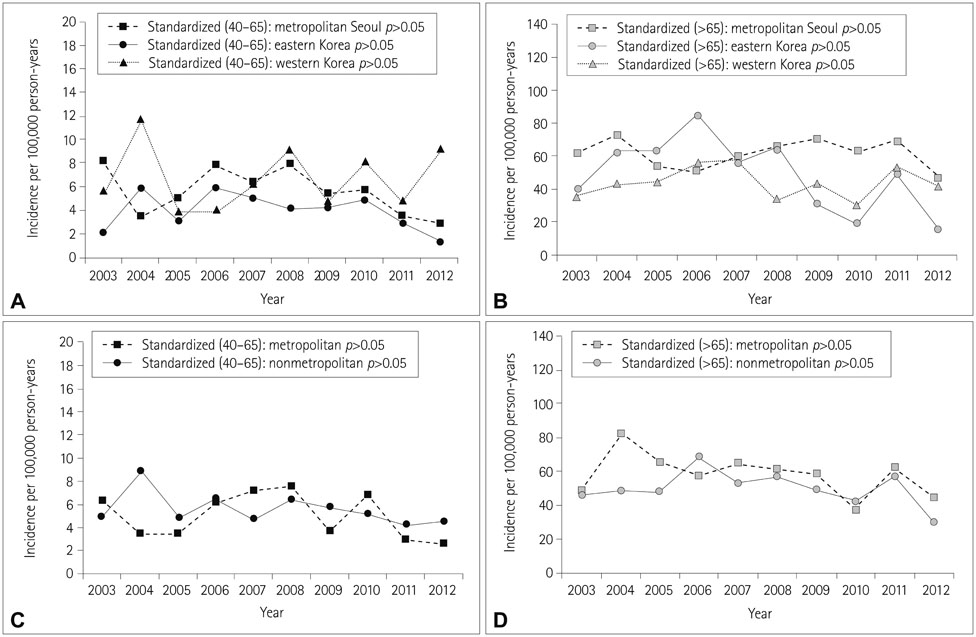J Clin Neurol.
2018 Oct;14(4):478-486. 10.3988/jcn.2018.14.4.478.
Region-Based Analysis of Prevalence and Incidence of Parkinson's Disease: Analysis of the National Sample Cohort in South Korea
- Affiliations
-
- 1Department of Neurology, Kangwon National University School of Medicine, Chuncheon, Korea. movement@kangwon.ac.kr
- 2Brain and Neural Science Researches Institute, Kangwon National University Hospital, Chuncheon, Korea.
- 3Department of Internal Medicine, Kangwon National University School of Medicine, Chuncheon, Korea.
- 4Department of Statistics, Kangwon National University, Chuncheon, Korea.
- KMID: 2424175
- DOI: http://doi.org/10.3988/jcn.2018.14.4.478
Abstract
- BACKGROUND AND PURPOSE
The rapid increases in the elderly population and urbanization in South Korea have influenced both demographics and the environment. This study investigated trends in the prevalence and incidence of Parkinson's disease (PD), and the associations of PD with the urban and rural environments in South Korea.
METHODS
This study examined subjects aged 40 years or older in a cohort constructed using the National Sample Cohort data set in South Korea during 2002-2013. We estimated the age-standardized prevalence and incidence of PD based on the 2002 population, and estimated their trends. We analyzed regional differences in these rates by dividing South Korea into three regions based on geographic characteristics and two regions based on the degree of urbanization.
RESULTS
The standardized prevalence rates of PD per 100,000 increased significantly from 75.8 in 2003 to 136.8 in 2012 (p < 0.0001), especially in older subjects. The standardized prevalence of PD was highest in metropolitan Seoul. The standardized incidence of PD per 100,000 was 13.9 in 2003 and 10.3 in 2012, with no significant trend (p>0.05). The standardized incidence of PD in younger subjects was lower in eastern Korea than in the other two regions, while in the older subjects it was lower in western Korea than in metropolitan Seoul over almost the entire analyzed period. The standardized incidence of PD did not differ significantly between metropolitan and nonmetropolitan areas.
CONCLUSIONS
The standardized prevalence of PD increased steadily from 2003 to 2012 in South Korea, while its standardized incidence has remained constant. There were regional differences in the prevalence and incidence of PD based on the degree of urbanization and the area of agricultural land.
Keyword
MeSH Terms
Figure
Reference
-
1. Dorsey ER, George BP, Leff B, Willis AW. The coming crisis: obtaining care for the growing burden of neurodegenerative conditions. Neurology. 2013; 80:1989–1996.
Article2. Findley LJ. The economic impact of Parkinson's disease. Parkinsonism Relat Disord. 2007; 13:Suppl. S8–S12.
Article3. Huse DM, Schulman K, Orsini L, Castelli-Haley J, Kennedy S, Lenhart G. Burden of illness in Parkinson's disease. Mov Disord. 2005; 20:1449–1454.
Article4. Driver JA, Logroscino G, Gaziano JM, Kurth T. Incidence and remaining lifetime risk of Parkinson disease in advanced age. Neurology. 2009; 72:432–438.
Article5. Kontis V, Bennett JE, Mathers CD, Li G, Foreman K, Ezzati M. Future life expectancy in 35 industrialised countries: projections with a Bayesian model ensemble. Lancet. 2017; 389:1323–1335.
Article6. Dorsey ER, Constantinescu R, Thompson JP, Biglan KM, Holloway RG, Kieburtz K, et al. Projected number of people with Parkinson disease in the most populous nations, 2005 through 2030. Neurology. 2007; 68:384–386.
Article7. Dauer W, Przedborski S. Parkinson's disease: mechanisms and models. Neuron. 2003; 39:889–909.8. Gupta A, Dawson VL, Dawson TM. What causes cell death in Parkinson's disease? Ann Neurol. 2008; 64:Suppl 2. S3–S15.
Article9. Sulzer D. Multiple hit hypotheses for dopamine neuron loss in Parkinson's disease. Trends Neurosci. 2007; 30:244–250.
Article10. Brown TP, Rumsby PC, Capleton AC, Rushton L, Levy LS. Pesticides and Parkinson's disease--is there a link? Environ Health Perspect. 2006; 114:156–164.
Article11. Noyce AJ, Bestwick JP, Silveira-Moriyama L, Hawkes CH, Giovannoni G, Lees AJ, et al. Meta-analysis of early nonmotor features and risk factors for Parkinson disease. Ann Neurol. 2012; 72:893–901.
Article12. Golbe LI, Farrell TM, Davis PH. Follow-up study of early-life protective and risk factors in Parkinson's disease. Mov Disord. 1990; 5:66–70.
Article13. Palin O, Herd C, Morrison KE, Jagielski AC, Wheatley K, Thomas GN, et al. Systematic review and meta-analysis of hydrocarbon exposure and the risk of Parkinson's disease. Parkinsonism Relat Disord. 2015; 21:243–248.
Article14. Priyadarshi A, Khuder SA, Schaub EA, Shrivastava S. A meta-analysis of Parkinson's disease and exposure to pesticides. Neurotoxicology. 2000; 21:435–440.15. Taba P, Asser T. Incidence of Parkinson's disease in estonia. Neuroepidemiology. 2003; 22:41–45.
Article16. An SJ, Lee SH, Lee SY, Kwon JW, Lee SJ, Kim YJ. Femur fractures in parkinsonism: analysis of a national sample cohort in South Korea. J Clin Neurol. 2017; 13:380–386.
Article17. Tak HM, Kim SH, Son IL. [A study on distributions and spatial properties of geomorphological mountain area]. J Korean Geogr Soc. 2013; 48:1–18.18. Choi BC, de Guia NA, Walsh P. Look before you leap: stratify before you standardize. Am J Epidemiol. 1999; 149:1087–1096.
Article19. Spiegelman M, Marks HH. I. Empirical testing of standards for the age adjustment of death rates by the direct method. Hum Biol. 1966; 38:280–292.20. Cochran WG. Some methods for strengthening the common χ2 tests. Biometrics. 1954; 10:417–451.21. Armitage P. Tests for linear trends in proportions and frequencies. Biometrics. 1955; 11:375–386.
Article22. Hughes AJ, Daniel SE, Lees AJ. Improved accuracy of clinical diagnosis of Lewy body Parkinson's disease. Neurology. 2001; 57:1497–1499.
Article23. Rajput AH, Rozdilsky B, Rajput A. Accuracy of clinical diagnosis in parkinsonism--a prospective study. Can J Neurol Sci. 1991; 18:275–278.24. Hughes AJ, Daniel SE, Kilford L, Lees AJ. Accuracy of clinical diagnosis of idiopathic Parkinson's disease: a clinico-pathological study of 100 cases. J Neurol Neurosurg Psychiatry. 1992; 55:181–184.
Article25. Hughes AJ, Daniel SE, Ben-Shlomo Y, Lees AJ. The accuracy of diagnosis of parkinsonian syndromes in a specialist movement disorder service. Brain. 2002; 125:861–870.
Article26. Joutsa J, Gardberg M, Röyttä M, Kaasinen V. Diagnostic accuracy of parkinsonism syndromes by general neurologists. Parkinsonism Relat Disord. 2014; 20:840–844.
Article27. Louis ED, Marder K, Cote L, Tang M, Mayeux R. Mortality from Parkinson disease. Arch Neurol. 1997; 54:260–264.
Article28. Elbaz A, Bower JH, Peterson BJ, Maraganore DM, McDonnell SK, Ahlskog JE, et al. Survival study of Parkinson disease in Olmsted County, Minnesota. Arch Neurol. 2003; 60:91–96.
Article29. Ishihara LS, Cheesbrough A, Brayne C, Schrag A. Estimated life expectancy of Parkinson's patients compared with the UK population. J Neurol Neurosurg Psychiatry. 2007; 78:1304–1309.
Article30. Diem-Zangerl A, Seppi K, Wenning GK, Trinka E, Ransmayr G, Oberaigner W, et al. Mortality in Parkinson's disease: a 20-year follow-up study. Mov Disord. 2009; 24:819–825.
Article31. Ho SC, Woo J, Lee CM. Epidemiologic study of Parkinson's disease in Hong Kong. Neurology. 1989; 39:1314–1318.
Article32. Okada K, Kobayashi S, Tsunematsu T. Prevalence of Parkinson's disease in Izumo city, Japan. Gerontology. 1990; 36:340–344.
Article33. Chen RC, Chang SF, Su CL, Chen TH, Yen MF, Wu HM, et al. Prevalence, incidence, and mortality of PD: a door-to-door survey in Ilan county, Taiwan. Neurology. 2001; 57:1679–1686.
Article34. Van Den Eeden SK, Tanner CM, Bernstein AL, Fross RD, Leimpeter A, Bloch DA, et al. Incidence of Parkinson's disease: variation by age, gender, and race/ethnicity. Am J Epidemiol. 2003; 157:1015–1022.
Article35. Tan LC, Venketasubramanian N, Hong CY, Sahadevan S, Chin JJ, Krishnamoorthy ES, et al. Prevalence of Parkinson disease in Singapore: Chinese vs Malays vs Indians. Neurology. 2004; 62:1999–2004.
Article36. Seo WK, Koh SB, Kim BJ, Yu SW, Park MH, Park KW, et al. Prevalence of Parkinson's disease in Korea. J Clin Neurosci. 2007; 14:1155–1157.
Article37. Yamawaki M, Kusumi M, Kowa H, Nakashima K. Changes in prevalence and incidence of Parkinson's disease in Japan during a quarter of a century. Neuroepidemiology. 2009; 32:263–269.
Article
- Full Text Links
- Actions
-
Cited
- CITED
-
- Close
- Share
- Similar articles
-
- The Association between the Triglyceride-Glucose Index and the Incidence Risk of Parkinson’s Disease: A Nationwide Cohort Study
- The Prevalence and Incidence of Parkinson's Disease in South Korea: A 10-Year Nationwide Population: Based Study
- Prevalence and Incidence of Dementia in South Korea: A Nationwide Analysis of the National Health Insurance Service Senior Cohort
- Study on the prevalence and incidence of urolithiasis in Korea over the last 10 years: An analysis of National Health Insurance Data
- Parkinson's Disease in Sub-Saharan Africa: A Review of Epidemiology, Genetics and Access to Care





